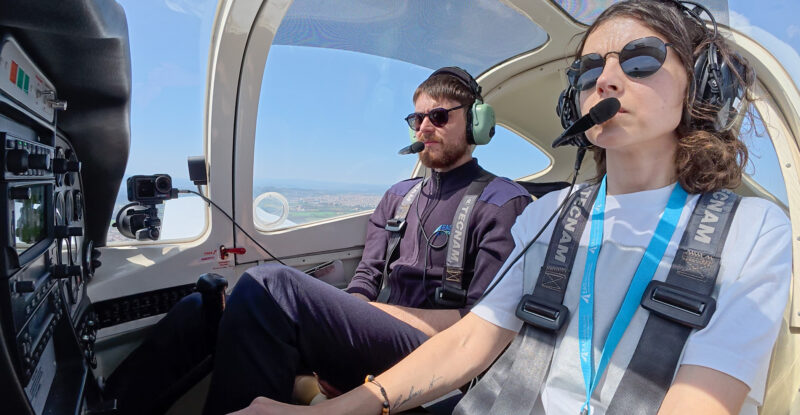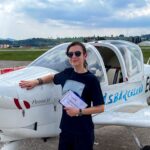Please enjoy this Op-Ed contribution from Assaia product manager Diana Vidstrom, who is also a student pilot.
When we discuss women in aviation, the focus is often on the flight deck, and for good reason. Female pilots make up only 6% of airline pilots globally (ALPA), so every increase is worth celebrating.
There is also an often-overlooked story in aviation: the growing presence of women shaping the systems, strategies, and technologies that form the industry’s operational backbone.
As someone building a career in aviation technology while also training to be a pilot, I’ve come to appreciate how essential these behind-the-scenes roles are to the bigger picture. One of the most critical examples is the turnaround — the short window between an aircraft’s arrival at the gate and its next departure, when a series of tightly coordinated tasks must happen quickly and safely. These tasks may seem routine, but they are part of a larger system of interdependent roles working in close coordination.
Collaboration between people and organizations with different responsibilities, be it in the air or on the ground, is the very essence of aviation, and it makes the industry safe, reliable, and increasingly sustainable.
Crucially, more women are leading, managing, and innovating within these critical operations, and they are equally important to those breaking barriers into the flight deck.
Where diverse experience meets operational excellence
At Assaia, I work with airports, airlines, and ground handlers to improve the turnaround. This phase includes everything from jet bridge docking and fuelling to cleaning, catering, and pushback, and it demands precise coordination across siloed teams, often under intense time pressure and shifting conditions to ensure the passengers get to their destinations on time.
Like many women in aviation, I arrived through a non-traditional path. I began in art history and worked in museums before transitioning into SaaS product management and entrepreneurship. My professional shift to aviation was a conscious step that took effort and dedication. Bringing a different set of experiences and ways of thinking into a new domain can be a strength, but in this field, a solid understanding of processes, procedures, and standards is essential.
It’s encouraging to see women applying expertise from diverse backgrounds like mine. This broadening of entry points reflects a wider shift in what modern aviation tends to appreciate. As the sector becomes more digital, data-driven, and sustainability-focused, there is growing space for people with hybrid skills and new perspectives.
Bridging insight with innovation
I often see people in the aviation industry develop in two or more roles; for example, many pilots were once flight attendants, flight dispatchers, or engineers. Being immersed in both product development and pilot training has stretched me technically and mentally, deepening my appreciation for the precision required in flight and ground operations, where good decisions rely on information, quick thinking, structure, and adaptability.
In a product development setting, this kind of knowledge is critical. To build tools that truly serve the industry, you need to understand your users’ daily realities. At Assaia, that connection is part of the culture. The environment is collaborative, with all our customers constantly evolving. It is the kind of place where you learn something new every day, and where that learning directly informs the value we deliver to airports and airlines.
While the industry has long followed established procedures shaped by safety and regulation, its future is increasingly influenced by technology and sustainability. Varied viewpoints, often forged from dual experiences, are vital to developing these systems in ways that meet new challenges without compromising what works.
A final thought
Aviation is evolving, not just through innovation but through collaboration. That progress depends on new voices and fresh perspectives. It is time we highlight not only women at the controls but also those shaping the systems behind every safe and on time departure.
As the aviation industry advances, there will be a shift in the skills that are most valued, with a growing emphasis on communication, broader thinking and cross-industry knowledge. Women, with their natural strengths in big-picture thinking, resilience, diplomacy, and long-term perspective, will be increasingly in demand, not only in operational roles but, hopefully, in executive positions too. Inclusion isn’t simply about access to roles, but about influence.
Diana Vidstrom is a product manager at aviation technology company Assaia and a student pilot currently completing her private pilot license in Spain.
She holds a master’s degree in sustainability in air transport management and is passionate about building bridges between flight, technology, and operational innovation.
Related Articles:
- Captain Emma Heering on how family and VistaJet help her fly high
- Jennifer Draughon of Neptune Aviation on aerial firefighting careers
- RAF’s Nina Wilkinson on managing the Typhoon Display Team
- JetBlue’s Anna Sieber helms Seamless Air Alliance Airline Forum
- Lily Aragon on leading fast-growing DOD and aero specialist Kros-Wise
- Leonardo UK AeroWomen 2024 provides insight on workplace inequality
All image credited to Diana Vidstrom














